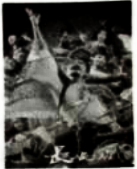阅读理解

Starting from primary school and continuing through high school, reciting masterpieces (著作) of Tang Dynasty poets such as Li Bai and Du Fu has always been an integral part of Chinese children's education.
This year, the film Chang An, directed by Xie Junwei and Zou Jing, has started a trend of Tang poetry. The film is set in the Tang Dynasty, an especially prosperous period of Chinese history from 618 to 907, and tells stories of famous poets, including Li Bai, Du Fu and Gao Shi in China. Seeing a child softly reciting the poems while writing the characters in the movie can be a familiar experience for Chinese audiences. Let's enjoy one of these famous poems.
Hard Is the Road of the World
Pure wine in golden cup costs ten thousand coins, good!
Choice dish in a jade plate is worth as much, nice food!
Pushing aside my cup and chopsticks, I can't eat;
Drawing my sword and looking round, I hear my heart beat.
I can't cross Yellow River: ice has stopped its flow;
I can't climb Mount Taihang: the sky is blind with snow.
I poise a fishing pole with ease on the green stream.
Or set sail for the sun and like the sage in a dream.
Hard is the way. Hard is the way.
Don't go astray! Whither today?
A time will come to ride the wind and cl eave the waves;
I'll set my cloud-like sail to cross the sea which raves.
The writer of this poem is highly honored with the title "The Poetic Genius (诗仙)". This poem expresses the writer's anger to the life; at the same time, it shows his positive attitude to making the dream come true, too.







